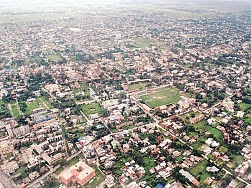Biratnagar
on Wednesday celebrated the centenary of its establishment. As the
birthplace of Nepal’s industrial history, congratulations are in order
on the occasion of the city’s 100th anniversary for its transformation
from a sleepy farming town into a manufacturing powerhouse.
The establishment of Biratnagar
Jute Mill was a major milestone that led to the opening of many other
industries in the city and surrounding areas. The expansion of
industries resulted in the formation of the Sunsari-Morang Industrial
Corridor, the country’s first industrial hub.
The 28-km corridor houses more than 500 small and large industries,
providing employment to around 100,000 individuals. Avinash Bohara,
president of Morang Merchant Association, says Biratnagar is the most suitable place/city when it comes to access to the international market. “ Biratnagar ’s close proximity to India’s Kolkata port gives the city an advantage for trade with countries other than India,” he said.
The industrial corridor accounts for one-thirds of the country’s total
production and business transaction. Industrial activities are projected
to grow further after the completion of the under-construction
Bathnaha-Katari broad-gauge railway, special economic zone and
integrated custom check post.
In the fiscal year 2012-13, Sunsari-Morang Industrial corridor imported
raw materials worth Rs 8.14 billion, and exported finished goods worth
Rs 18.65 billion, according to Biratnagar Customs. Economist Bhesh Prasad Dhamala says Biratnagar has the potential to be developed as a trade and transit hub.
In recent years, education and health institutions have been thriving
in the city. Billions of rupees worth of investment has been made in
health and education sector. Rapid expansion of physical infrastructure
and quality teaching has made Biratnagar an “education hub” of the east.
The private sector has injected a huge amount of money in the medical
field. There are more than two dozen hospitals and nursing homes in Biratnagar .
Biratnagar
has, to some extent, curbed migration of students to India. “Now, the
city has been established as an education hub of the eastern region,”
said Dinesh Subedi, a professor. “The education sector will be more
competitive if it is well managed.”
Once the centre of economic activities, Biratnagar
is now struggling to keep its glorious past alive. Despite having some
of the largest industries in the country, the city is lagging behind in
terms of attracting investors and investment.
Entrepreneurs, however, say all is not lost. “The city can rebound if
we can manage basic infrastructure,” said Bohara, stressing on the need
for right policies and plan by the government. The eastern region has a
huge potential in livestock and dairy business, so the government needs
to launch targeted programmes to encourage farmers, he said.
As Biratnagar
can be transformed into a potential trade and transit hub, traders
have underscored the need for reducing transit costs. Establishment of
the Nijgadh-Kathmandu corridor can play an important role in reducing
the transport distance for goods imported from India and third countries
via Biratnagar .
Goods imported from countries other than India are first shipped to
Kolkata port, and then transported to Birgunj through road (950km),
while the travel distance from Biratnagar and Kolkata is 624km. “The transport distance will be shortened significantly if goods are first ferried to Biratnagar and then transported via Nijgadh-Kathmandu corridor to the Capital,” said Bohara.
In terms of cost, rail freight is relatively cheaper. For instance,
transportation charge from Jogbani-Kolkata link is Rs 1,760 per tonne,
while that via railway is Rs 920 per tonnes. “As freight cost can be
reduced by 52 percent, linking Biratnagar to Broad-gauge railway in Jogbani will automatically reduce the prices commodities,” entrepreneurs said.
The government will also have to seek India’s support to link Biratnagar
with Rohanpur, bordering Bangladeshi town, via Jogbani with railway.
The rail distance between Jogbani and Rohanpur is just 230km. If
established the link to Rohanpur, which is 606 km away from Mangala Port
of Bangladesh, will make transportation of goods to the port a lot
easier.
If India allows Nepal to use its railway network to Rohanpur, it will
make it easier for Nepal to import jute, medicine, garment, powdered
milk, iron, chemical fertilisers, industrial raw materials and Chinese
ceramics. Nepal will also be able to export meat, lentils, foodstuff,
seeds, wheat, dairy products and stones to Bangladesh.
It can also be developed as a transit point for cross-country trading by constructing Biratnagar -Kimathanka road, said Kishor Pradhan, president of Eastern Region Chamber of Commerce and Industry.








No comments:
Post a Comment